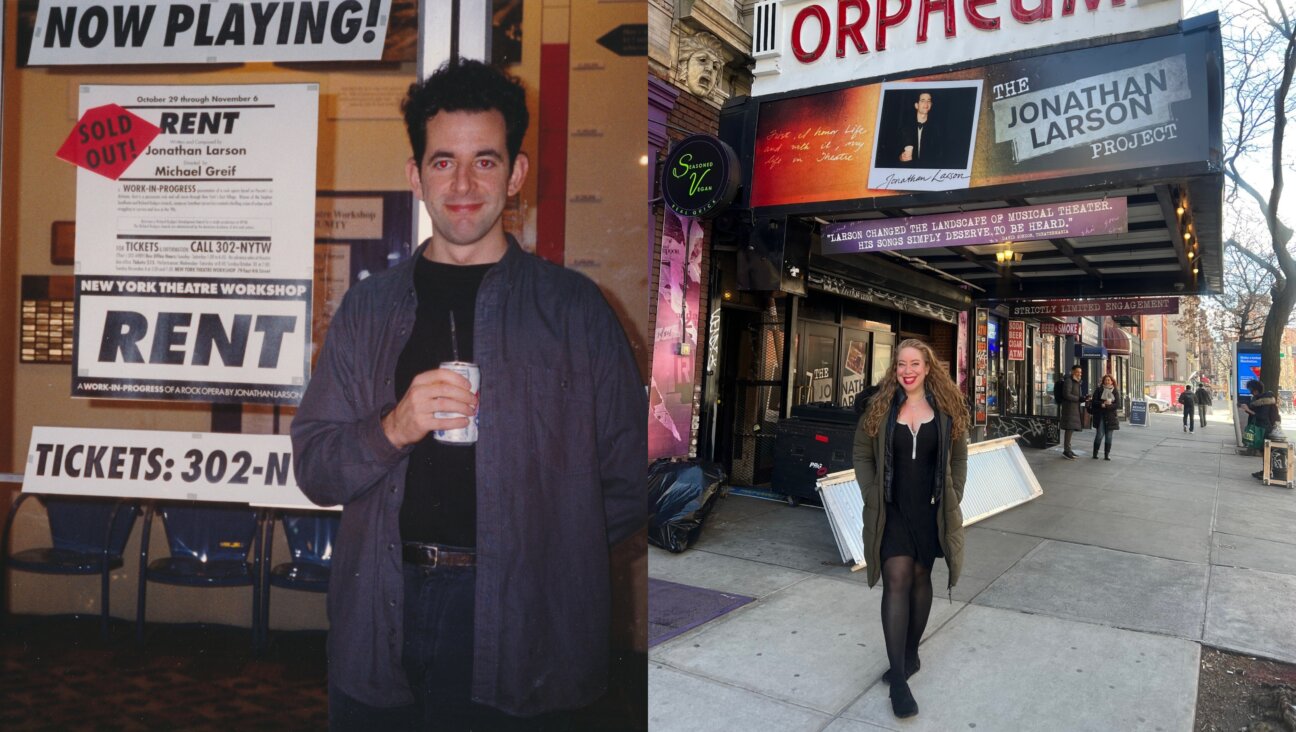Though it looked to the past, ‘Hester Street’ was way ahead of its time
Joan Micklin Silver’s film was an indie long before the heyday of independent cinema

Graphic by Angelie Zaslavsky
Years ago, I sat on a panel about the 1975 movie, “Hester Street.” The event was hosted at an Appalachian college where, let’s just say, the tribe of Israel is not over-represented. I came out of maternity leave to participate and was still breastfeeding at the time, so I was suffering the sharp pangs that come from being away from home for hours at a time. The other two panelists, both men, started us off by discussing the source novel for the movie and sharing details about the production of this Yiddish/English-language film. I nodded and smiled through the pain, praying for time to move quicker.
“It’s a film about women!” I wanted to shout. “It’s a film about Jewish women! The movie is called ‘Hester Street,’ not ‘Schmuel Avenue!’ Can we just talk about how it’s about women?”
“Hester Street” covers a lot of ground in its 91-minute run time: marriage and motherhood, Judaism and secularism, and the ways in which women’s experiences echo through time. But despite its ambitions, it has failed to receive the widespread attention it merits, falling between the cracks for cinephiles; it is neither the archetypal “1970s Hollywood movie,” nor does it belong to the illustrious tradition of the “European art film.”
“Hester Street” is an American indie in the most proper sense of the word. As film historian Maya Montanez Smukler has written, writer-director Joan Micklin Silver and her husband, Ray, self-financed “Hester Street” when the regular “boys’ club” channels all passed. The film found audiences and critical praise by taking the movie on the festival circuit, at which time the Silvers received informal mentorship from independent film icon, John Cassavetes.
But now that the Cohen Media Group has restored “Hester Street,” the film may be finally getting its due. It is funny to talk about “restoring” “Hester Street,” since it was made to look like an exhibit of the past: black-and-white film stock, unknown actors, and an opening sequence seemingly ripped from an old silent film.
In “Bridge of Light: Yiddish Film Between Two Worlds,” J. Hoberman writes of the rich body of Yiddish cinema that came out of New York in the early 20th century, popularly screened for and beloved by Lower East Side residents. But while Micklin Silver pays homage to this cinematic tradition, she also gives new life to what is, for many Ashkenazi families and American audiences, a familiar story: the Old-World Patriarch, passing through Ellis Island, struggling to remake himself and his family in a new land. It’s a tale older than “An American Tale” and with only a fraction of the number of rodents dotting the cityscape.
When “Hester Street” was first released, Jay Cocks, writing for Time Magazine, complained that “it is in Jake’s story that the trials and compromises of assimilation are most easily perceived. But writer-director Silver gives as much attention to Bernstein and Gitl, even to Mamie, and so loses her central conflict.”
The writer is only half-correct. On its surface, “Hester Street” is about Yekl/Jake (Steven Keats), an immigrant torn between his fresh-off-the-boat wife, Gitl (Carol Kane) and his secular-Jewish, American mistress, Mamie (Dorrie Kavanaugh).
As a Jewish woman who took a class in college called “The Jewish Woman” (you can check my transcript), I am admittedly biased, but I never imagined the film’s pivot toward the women of “Hester Street” could be a mistake. Love may work in mysterious ways, but Micklin Silver’s feminist mission is laser-focused, as “Hester Street” smartly dismantles the long-stale cinematic trope of the Jewish man choosing between tradition and assimilation. In the effort to reinvent himself, Jake turns the two women in his life into symbols of the past and the present, of what he was and what he might become.
It makes for a neat “central conflict,” sure, but the complex Jewesses of “Hester Street” refuse to be devices; they hijack the movie as it might be and turn it into something new. Gitl and Mamie are specific and surprising, and by focusing on their lives, Micklin Silver turns her adaptation of the 1896 novel “Yekl: A Tale of the New York Ghetto,” by Forward founder Ab Cahan, into a radical commentary on narrative inheritances, familial, literary and cinematic.
The most acclaimed element of the film has always been Carol Kane’s performance as Gitl, which earned the actress an Oscar nomination. American audiences have seen Kane in movies and television shows like “Annie Hall,” “Taxi,” “The Princess Bride” and “The Unbreakable Kimmy Schmidt.” From the sum of these roles and others, she is known as a kooky Muppet of a woman with doe eyes and a baby voice that can turn raspy on a dime. By contrast, Kane’s performance here is quietly expressive, revealing steeliness beneath her soft, girlish features. (It’s astounding that she was able to achieve this acting mostly in Yiddish, a language she didn’t speak.)
When we first meet Gitl, she is wearing a round, unflattering wig, seated next to her son with a tag pinned to her clothes (presumably because she cannot speak English). She is more doll than woman. But when, under pressure from her husband, Gitl goes “fixing [herself] up,” Jake grows violent, scandalized by her modern attire and Kane’s signature luxurious, libidinal curls. Her frumpiness embarrassed him, but her transformation poses a new threat, as Jake is faced with how much he can leave his life as Yekl in the past.
Only Bernstein (Mel Howard), Jake’s co-worker and the family’s Yeshiva-trained boarder, recognizes Gitl’s wit, strength and multidimensionality. And while Gitl’s reverence for the study of Torah marks her as old-fashioned to the men and women around her, it is her love of learning that precipitates a more equal or “modern” relationship with Bernstein. When Gitl finally permits Jake a divorce, Bernstein is too shy to propose, offering to pack up and end their boarding arrangement. In response, Gitl calmly begins to unpack his things, cutting the strings that hold his books together. When Bernstein asks what she is doing, she replies, simply, “I am saying yes.” Their tender handholding at scene’s end illustrates how romance can bloom when old meets new, when tradition gets a sexy, but restrained, update.
Meanwhile, the coupling of self-proclaimed “Yankee” Jake and Mamie is presented as something less than liberatory. In depicting this dynamic, Micklin Silver explores the misunderstood, vilified figure of the sophisticated city girl. Dorrie Kavanaugh’s underrated performance as Mamie gives breadth and depth to the dangerous vamp type of silent film. When we first encounter Mamie in the film’s opening scene, she is flirting with every man in the room, laughing and coquettishly fanning her dance partner. Having come over from Poland as a teenager all on her own, she has managed to save up money, explaining, “I don’t want no man to say I had to take her just as she was, without a penny.”
But when Mamie thinks that Jake is on the verge of proposing, not yet knowing he is already married, she hands over a chunk of her savings without complaint. “This is a different thing now, ain’t it?” she says sweetly. “You’re the boss now.”
This brittle good-time girl is willing to surrender her self-determination for the chance of love and commitment. When she discovers that Jake uses the loan to furnish an apartment for his wife and son, Mamie’s vindictive intentions quickly give way, as she and Jake kiss in the hallway outside his apartment. But Mamie’s tears are not those of a manipulative seductress. She weeps because she is stuck in the role that Jake, and so many stories, have cast her: the heartless homewrecker, representative of all the shallow pleasures American life has to offer. But because Micklin Silver is revising the old story, Mamie is not punished for her transgression but rewarded with her own happy (if indeterminate) ending.
All Gitl and Mamie want is the freedom to author their own futures, and “Hester Street” emphasizes how women throughout history have fought to tell their own stories, even when they lack the agency or resources to do so. In many ways, the film is a second-wave feminist fable, a kind of “usable past,” and a metaphor for how Micklin Silver made film art without garnering the support of a male-run Hollywood establishment. As landlady Mrs. Kovarsky (Doris Roberts) declares with aplomb, “You can’t pee down my back and tell me it’s raining!” A slogan for a Women’s March sign if ever I read one.
Yet, these readings neglect the subtler themes of unspoken, inexpressible, connection: between women and between moments in time. In the last scene of the film, Gitl (with Bernstein) and Mamie (with Jake) walk the streets of the Lower East Side. They tread the same bumpy cobblestone path of the film’s title, one named after Queen Esther, who, in securing the love of a king, ensured the continuity of the Jewish people. The wife and the vamp — the Esther and the Vashti — have long been pitted against each other, historically and narratively. But might not these two women understand one another better even than their spouses do?
Just so, “Hester Street” sees these women more clearly than do most proper histories and literary renderings, offering, in its final moments, a crane shot pulling away from Gitl, her husband and her son, as they blend into the crowd and wander off-screen. As a scholar, I have spent much of my career trying to recover women’s unsung contributions to American media, and, in my own life, I often reflect on the stories of familial foremothers I never got to meet. (One was a brilliant seamstress, so I’m told, while another was an avid reader of TV Guide; I won’t make you guess which set of genes I inherited.)
For me, “Hester Street” has always been about cultural restoration—restoring the Gitls and Mamies to their proper place in the story without relegating them to ancient history. We should hold these women’s stories close, because their hopes and trials remain vivid and pressing. I maintain, now as then, that “Hester Street” is a movie about Jewish women — past, present and future.
The restored version of “Hester Street” premieres Saturday, Sept. 25, at the New York Film Festival.
Annie Berke is the Film Editor at the Los Angeles Review of Books. Her book, Their Own Best Creations: Women Writers in Postwar Television, is forthcoming from the University of California Press (January 2022).
















